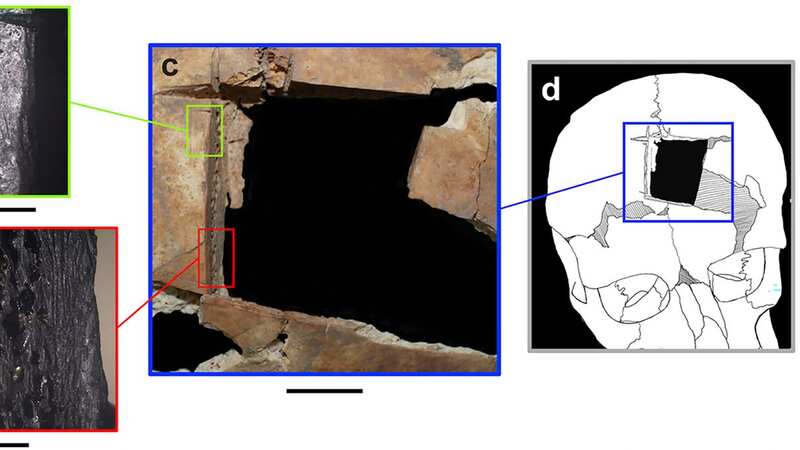

The earliest evidence of a rare type of brain surgery has been found, dating from the 15th century BC.
Scientists examined the remains of two individuals - thought to be brothers - buried in a tomb at the archaeological site of Tel Megiddo, a national park.
One of the skulls has a square hole in the frontal bone, slightly larger than one inch square, where a piece was surgically removed as part of an ancient medical procedure known as trephination.
Although this procedure is thought to have existed for thousands of years, experts said this type of trephination is the earliest example of its kind to be found in the ancient Near East - which covers western Asia, south-eastern Europe and north Africa.
Doctors today perform a similar procedure, known as craniotomy, to treat tumours or blood clots or remove foreign bodies such as bullets.
 Archaeologists make incredible discovery of 5,000-year-old pub with food inside
Archaeologists make incredible discovery of 5,000-year-old pub with food inside
Rachel Kalisher, a doctoral student at Brown University’s Joukowsky Institute for Archaeology and the Ancient World in the US, said: “We have evidence that trephination has been this universal, widespread type of surgery for thousands of years.
“But in the Near East, we don’t see it so often - there are only about a dozen examples of trephination in this entire region.”
 Rachel Kalisher, a doctoral student at Brown University, working a the field in Tel Megiddo, Israel, where the earliest evidence of an "uncommon" type of brain surgery performed some time in the 15th century has been unearthed by archaeologists (PA)
Rachel Kalisher, a doctoral student at Brown University, working a the field in Tel Megiddo, Israel, where the earliest evidence of an "uncommon" type of brain surgery performed some time in the 15th century has been unearthed by archaeologists (PA)The scientists believe one of the brothers had undergone a specific type of cranial surgery called angular notched trephination.
The procedure involves carving four intersecting lines in the skull and using leverage to create a square hole.
Experts believe this type of medical treatment was rare in the region and only accessible to the elite.
Analysis of the bones suggests both brothers suffered from some form of chronic disease.
Ms Kalisher said: “These brothers were obviously living with some pretty intense pathological circumstances that, in this time, would have been tough to endure without wealth and status.”
She said that if the angular notched trephination was meant to keep the brother alive, it didn’t succeed as he died within days, hours or perhaps even minutes of the surgery.
Ms Kalisher said: “You have to be in a pretty dire place to have a hole cut in your head.
“I’m interested in what we can learn from looking across the scientific literature at every example of trephination in antiquity, comparing and contrasting the circumstances of each person who had the surgery done.
 Roman dildo discovered as experts re-examine 2,000-year-old wooden phallus
Roman dildo discovered as experts re-examine 2,000-year-old wooden phallus
“In antiquity, there was a lot more tolerance and a lot more care than people might think.
“We have evidence literally from the time of Neanderthals that people have provided care for one another, even in challenging circumstances.
“I’m not trying to say it was all kumbaya - there were sex- and class-based divisions. But in the past, people were still people.”
The researchers believe the upper-class brothers lived in Megiddo around the 15th century. Possibly even royalty themselves.
Their tombs were found adorned with high-quality food and ceramics similar to other nearby high-status tombs.
One of the brothers is thought to have died in his teens or early 20s and the other some time between his 20s and 40s, both possibly with some form of infectious disease.
Writing in the journal Plos One, the researchers said: “Among the study’s multiple findings, we wish to highlight the special type of cranial trephination, the earliest of its kind in the region.
“This uncommon procedure was done on an elite individual.”